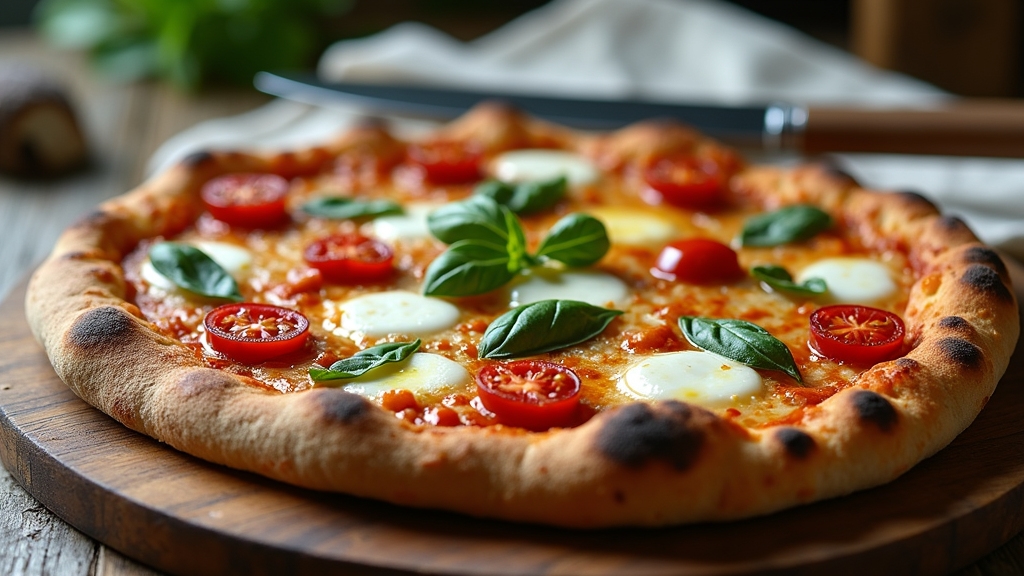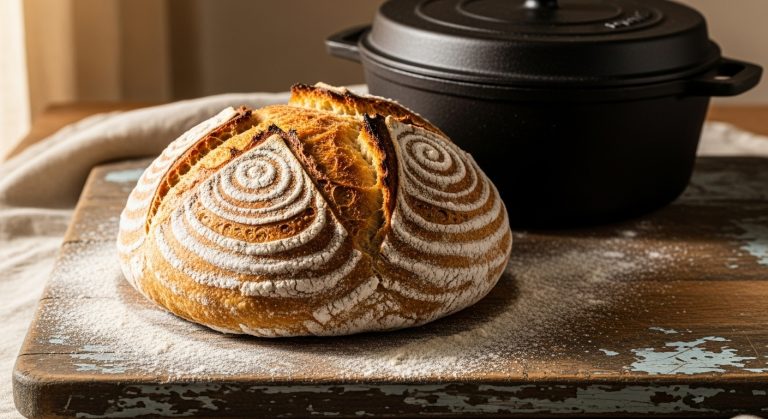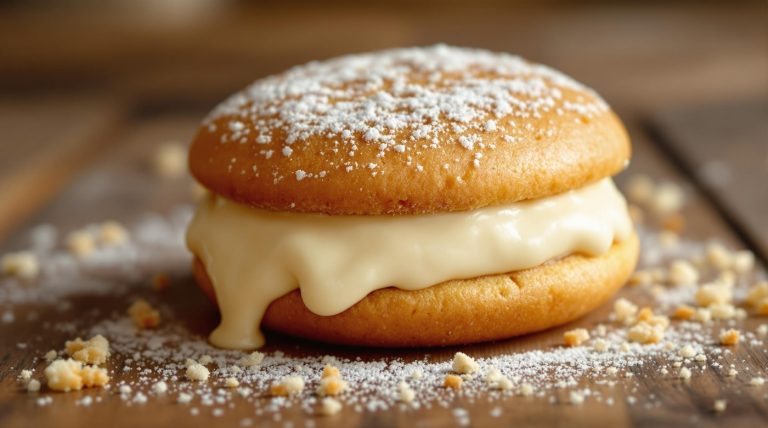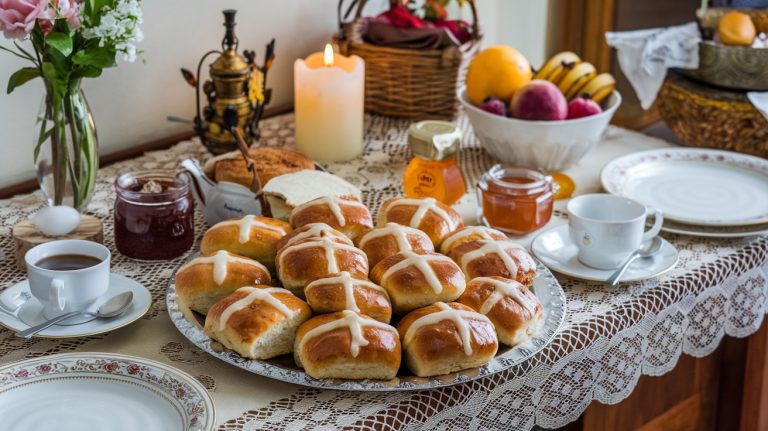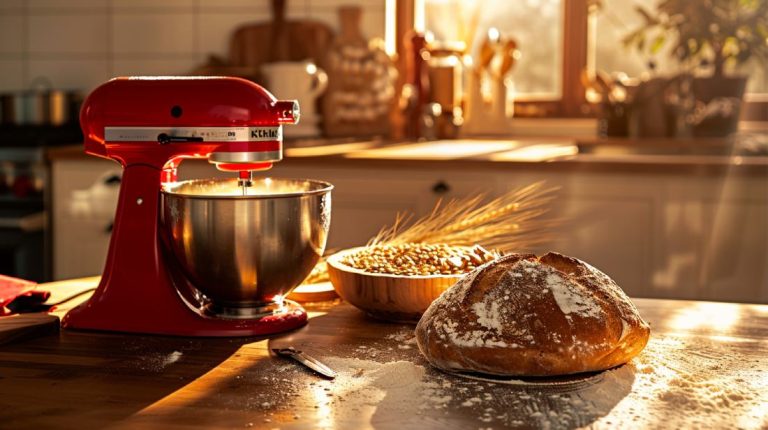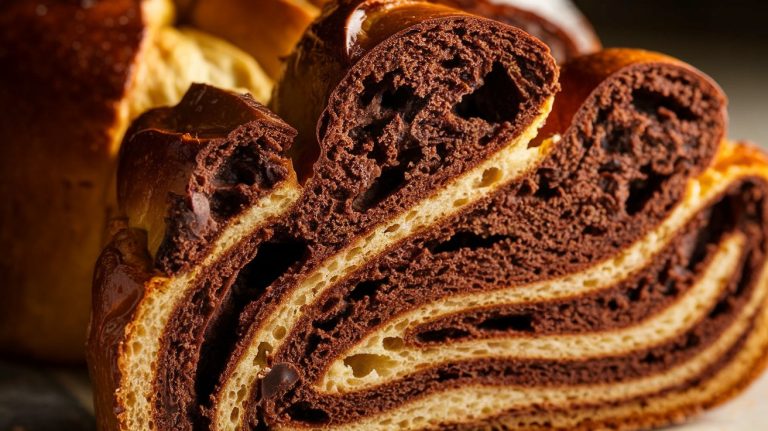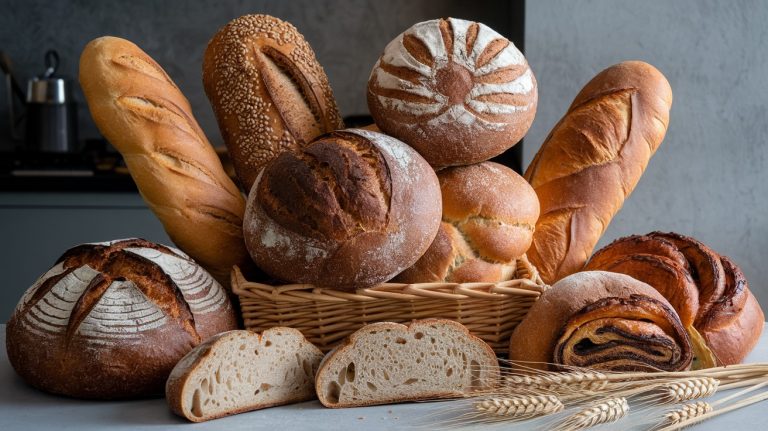Quick Sourdough Flatbread Pizza with Artisan Flavor
To craft sourdough flatbread pizza, start with high-protein flour and an active sourdough starter (5–10%) for proper fermentation. Mix and gently knead, then bulk ferment at 78–80°F until the dough partially rises.
Shape into tight discs, pre-bake briefly at 500°F for stability, then add balanced, prepared toppings. Bake at high heat on a stone or steel for crispness.
Mastering flour types, hydration, and fermentation will elevate your flatbread to perfect texture and flavor.
Key Takeaways
- Use bread flour or a blend with whole wheat einkorn for chewy, flavorful sourdough flatbread with adjusted hydration (60-80%) for extensibility.
- Incorporate 5-10% active sourdough starter, ferment dough 3-9 hours at 18-26ºC, using stretch-and-folds to develop gluten and flavor.
- Shape dough into tight discs, gently stretch without over-flouring, and par-bake crust at 500-550°F for 1.5-5 minutes until pale and stable.
- Select fresh, balanced toppings with contrasting textures and flavors; pre-cook vegetables and meats to reduce moisture and enhance taste.
- Bake on preheated stone or steel at 450-550°F using convection, placing pizza low in the oven for 8-15 minutes until crust is crisp and golden.
The Simplest Sourdough Pizza Crust Recipe
| Step | Ingredients / Tools | Measurements & Notes | Process |
|---|---|---|---|
| Dough Base | Bread flour or all-purpose flour | 250–300g (blend with whole wheat for depth) | Provides structure, chew, and flavor |
| Active sourdough starter | 25–30g (5–10% inoculation) | Adds natural leavening & tang | |
| Water | 150–200ml (60–80% hydration depending on flour) | Adjust based on flour absorption | |
| Salt | 6g | Enhances taste & balances fermentation | |
| Olive oil | 1 tbsp | Improves elasticity & moistness | |
| Fermentation | Bowl + cover | — | Bulk ferment 3–9 hrs at 18–26°C with 2–3 stretch & folds |
| Shaping | Dough scraper & floured surface | — | Divide into discs, gently stretch to desired thickness |
| Pre-Bake | Pizza stone or steel | Preheated to 500–550°F | Par-bake 1.5–5 min until pale & stable |
| Toppings | Fresh mozzarella, tomatoes, cured meats, roasted veggies, herbs | As desired | Pre-cook moist toppings; balance flavors & textures |
| Final Bake | Oven with stone/steel | 450–550°F for 8–15 min | Bake until crust is crisp & golden |
| Serving | Fresh basil, olive oil drizzle | Optional | Finish with fresh herbs or drizzle for extra flavor |
Essential Ingredients for Sourdough Flatbread Pizza Dough

When crafting sourdough flatbread pizza dough, selecting the right flours is essential because they directly influence the dough’s texture, hydration needs, and flavor complexity. You’ll often use all-purpose flour for balanced gluten development and texture, while bread flour’s higher protein content boosts chewiness and structure.
Incorporating whole wheat einkorn flour adds a nutty flavor and nutritional value but requires adjusting water since whole grains absorb more. Combining flours, such as all-purpose with bread flour, optimizes consistency and depth. Using a sourdough mix like Krusteaz’s can simplify preparation and provide consistent results due to its artisan bread mix formulation.
Alongside flour, an active, bubbly sourdough starter at about 75% hydration naturally leavens the dough and enriches flavor. Salt fine-tunes taste and yeast activity, while olive oil enhances elasticity and moistness. This dough can be prepared with minimal effort without requiring specialized equipment.
Precise ingredient selection guarantees a dough primed for fermentation and baking success.
Preparing and Fermenting the Dough
You’ll start by mixing the dough to achieve a uniform hydration and gluten network, using techniques like autolyse and gentle folding. Incorporating a sourdough starter at 5-10% inoculation enhances flavor and fermentation control.
Timing your bulk fermentation is essential—adjust it based on ambient temperature to control yeast activity and dough development. Using a waterproof cover during fermentation helps maintain dough moisture and prevents drying out.
Precision in these steps guarantees your dough gains ideal strength and flavor for a perfect sourdough flatbread crust. For best results, perform up to three rounds of stretch and folds during bulk fermentation to improve dough structure and gas retention dough strengthening.
Dough Mixing Techniques
Although preparing sourdough flatbread pizza dough demands patience, mastering the mixing and fermenting stages guarantees a well-developed gluten network and balanced fermentation.
Start by combining flour, water, salt, and active levain or starter at low speed until a shaggy dough forms. Gradually increase mixing speed or knead for 5-7 minutes to develop gluten structure. Drizzle in olive oil during mixing for even absorption, ensuring a cohesive, soft dough—not overly wet.
After mixing, let the dough rest for 10 minutes to hydrate flour and improve gluten development when you resume. Using a proofing basket during fermentation can help maintain dough shape and enhance the final texture.
Bulk ferment the dough at 78-80ºF for 3-4 hours, covered to avoid drying, allowing volume increase and flavor development. This process can be followed by refrigerating the dough for up to two days to enhance flavor through long cold fermentation.
Optionally, apply stretch and folds to strengthen extensibility, but for flatbread pizza, minimal handling suffices.
Fermentation Timing Tips
Mastering fermentation timing shapes the dough’s flavor, texture, and rise. Adjust your bulk fermentation based on ambient temperature: at 18°C, expect around 9 hours for a 10% volume increase, while at 26°C, it shortens to about 4 hours.
Target a 10-75% volume increase—not full doubling—to preserve yeast vitality for final proofing. Incorporate 3-4 stretch-and-fold sets every 30-60 minutes to develop gluten and improve extensibility.
After bulk fermentation, shape the dough into a taut boule before cold refrigeration at 4°C. This can last overnight to several days, enhancing flavor complexity and dough strength.
Use visual cues like small surface bubbles and volume marks to monitor progress. Precise control of timing and temperature guarantees ideal dough structure and promotes the airy, flavorful crust characteristic of sourdough flatbread pizza.
For the best baking results, using the right bakeware, such as a heavy-duty springform pan, can enhance heat distribution and crust development.
Selecting and Preparing Toppings

You’ll want to choose fresh, high-quality ingredients to guarantee each topping enhances the sourdough’s flavor and texture. Using bowls with consistent temperatures for proofing can improve dough rise and flavor development.
Balancing complementary tastes—like creamy mozzarella with tangy tomatoes or spicy salami with mild cheese—creates a harmonious profile.
Proper preparation is key. Roasting vegetables brings out their natural sweetness and softens them for even cooking.
Using natural fermentation in the dough enhances the overall flavor experience when paired with well-prepared toppings.
Thinly slicing meats helps them cook evenly and prevents the flatbread from becoming soggy.
These steps ensure ideal moisture control and a perfectly cooked, flavorful flatbread.
Choosing Fresh Ingredients
When selecting and preparing toppings for sourdough flatbread pizza, focus on freshness and quality to guarantee ideal flavor and texture.
Choose cheeses free from preservatives, such as fresh mozzarella for creamy melts or crumbled feta for tang.
Select firm, ripe vegetables—tomatoes without bruises, crisp bell peppers, and unwilted leafy greens—to maintain structure and moisture. Maintaining a consistent warm temperature during dough fermentation also enhances the final texture.
For meats, pick thinly sliced, lean cured options and ensure fresh sourcing with clear expiration dates.
- Wash and dry vegetables thoroughly; slice just before assembly to prevent moisture loss.
- Store cheese and meats at proper refrigeration temperatures to preserve freshness.
- Pre-cook raw meats fully to ensure safety and consistent texture.
Additionally, using homemade sauce made simply with balsamic vinegar and minimal ingredients can complement the fresh toppings perfectly, enhancing the overall pizza flavor. This method reflects the homemade sauce simplicity highlighted in the recipe.
Prioritize these steps to enhance your pizza’s balance of texture, flavor, and appearance.
Balancing Flavor Combinations
Although sourdough flatbread provides a distinct tangy foundation, balancing your toppings by combining contrasting flavors and textures guarantees each bite remains dynamic and harmonious.
Pair tangy sauces like marinara with rich cheeses such as fresh mozzarella to complement sourdough’s acidity.
Incorporate umami elements like prosciutto or olives to deepen complexity.
Use varied textures—creamy burrata, crunchy roasted peppers, and chewy cured meats—to enhance mouthfeel. Maintaining a consistent dough temperature around 75°F (optimal yeast performance) during preparation ensures the best texture for your flatbread.
Select toppings with complementary color contrasts for visual appeal. The natural bacteria and probiotics in sourdough discard contribute to its gut health benefits, enhancing the overall nutritional value of your pizza.
Sweet roasted vegetables or hot honey drizzle counterbalance sourdough’s sourness effectively.
Avoid overwhelming the flatbread by moderating spicy cured meats with milder vegetables.
Layer cheeses strategically to showcase melting behaviors and flavor nuances.
This precise equilibrium ensures every slice delivers a balanced, engaging profile that respects sourdough’s unique character.
Preparation Techniques
Since the toppings define both flavor and texture, selecting ingredients that harmonize with sourdough’s tangy profile is vital. You want to balance moisture, texture, and flavor intensity carefully. Using a well-fermented sourdough starter helps create a crust that supports these toppings without becoming soggy.
Begin by choosing fresh, high-quality produce and proteins, then prepare them to optimize performance on the flatbread. Historically, various cultures have embraced topped flatbreads, highlighting the ancient roots of this culinary concept.
Slice vegetables thinly or pre-cook to reduce moisture and enhance texture, avoiding soggy crusts. Dry leafy greens thoroughly to maintain a crisp texture and prevent excess water from affecting the dough’s rise and consistency.
Grate or slice cheeses evenly, combining mild and sharp varieties for balanced richness without greasiness.
Pre-cook meats to render fat, pat dry, and cut into bite-sized pieces for uniform heat distribution.
Apply toppings strategically—drier items first, wetter ones later—to maintain crust integrity and ensure even baking. This layering technique also allows for optimal bulk fermentation effects on dough structure and flavor development.
Techniques for Shaping and Pre-Baking the Crust
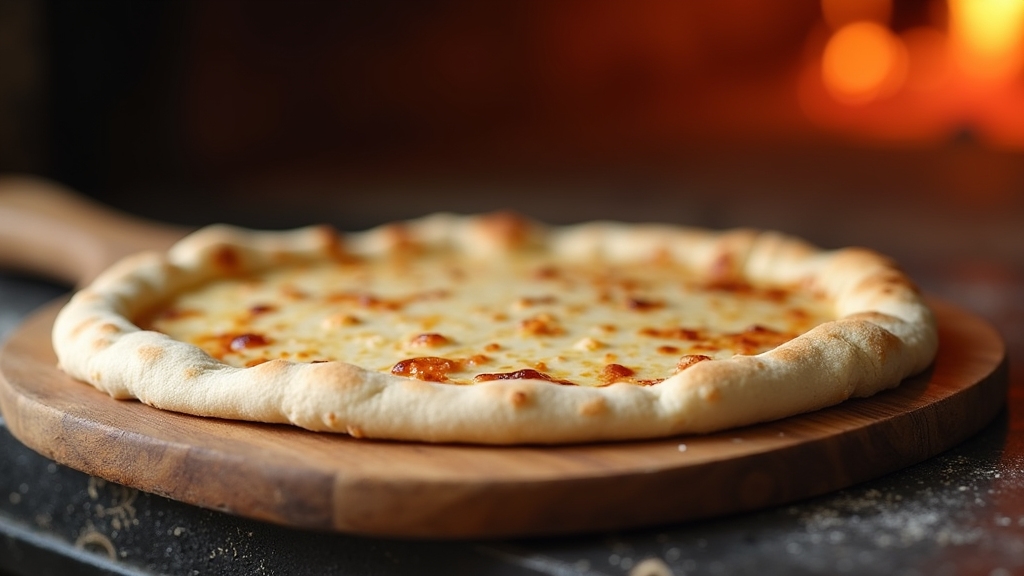
Mastering the techniques for shaping and pre-baking the sourdough flatbread crust hinges on controlling dough tension and temperature to guarantee ideal texture and structure.
Divide the fermented dough into uniform balls, shaping each into a tight, smooth sphere by pinching and rotating to build surface tension. Rest balls seam side down, covered, to relax gluten.
Lightly flour your hands and work surface, then press the dough ball into a disc, stretching gently with an inverted “V” hand shape or over knuckles for even thickness. Avoid over-flouring to maintain hydration.
Preheat your oven or skillet to 500°–550°F. Par-bake the crust 1.5 to 5 minutes until pale and stable, using a peel or parchment for transfer. Using more flour during shaping helps prevent sticking and ensures a smooth process, which is essential for handling sourdough dough effectively.
This step guarantees steam release and a firm base, preventing sogginess under toppings.
Baking Tips for Perfect Flatbread Pizza
When aiming for a perfectly baked sourdough flatbread pizza, controlling your oven temperature and environment is vital. Preheat your oven to 450°F–550°F (230°C–288°C) with a pizza stone or steel inside for at least 30 minutes. This helps stabilize the heat and guarantees even cooking. For best results, consider the benefits of resistant starch formation in sourdough, which can be enhanced by baking techniques.
Perfecting sourdough flatbread pizza starts with preheating your oven to 450°F–550°F with a pizza stone or steel.
Follow these tips to optimize your bake:
Use a convection or convection roast setting to enhance heat circulation. This produces a crisper, evenly browned crust.
Bake on parchment paper initially, then remove it midway. This allows direct contact between the dough and the hot surface, intensifying bottom crispness.
Place the pizza on the lower oven rack to maximize bottom heat exposure. This helps avoid sogginess and supports the development of a golden, crispy crust.
Monitor baking time carefully—typically 8 to 15 minutes. Adjust based on dough thickness and topping moisture to prevent under- or over-baking.
Customizing Flours and Hydration for Desired Texture
Controlling oven conditions sets the stage, but the flour and hydration you choose define the dough’s character and texture.
Opt for bread flour with 11-13% protein to develop a strong gluten network, enabling hydration levels of 70-80%, which yield a chewy, airy crust. Bread flour is also versatile for baking on steel, pizza stone, or cast iron skillet, offering multiple cooking options.
Tipo 00 flour, finely ground with moderate protein (~11-12%), suits thinner, tender crusts at 60-65% hydration due to its lower water absorption.
All-purpose flour, with less protein, produces softer, denser dough, often requiring hydration below 60%.
Adjust hydration meticulously, considering flour grind, protein content, and ambient humidity, to maintain dough extensibility and fermentation stability.
Blending specialty flours enhances flavor complexity without compromising structure. For example, incorporating semolina flour adds crunch and chewiness that can improve crust texture when combined with other flours.
Frequently Asked Questions
How Long Can Leftover Sourdough Flatbread Pizza Be Stored Safely?
You can safely store leftover sourdough flatbread pizza in your refrigerator for 3 to 5 days. Use airtight containers or sealed bags to prevent moisture loss and contamination.
Keep it at 34°F to 40°F (1°C to 4°C) and refrigerate promptly after cooling.
Beyond 5 days, the risk of mold and bacteria grows. Always check for any off smells or visible mold before eating to guarantee safety.
Can Sourdough Flatbread Pizza Dough Be Frozen Before Baking?
Absolutely, you can tuck your dough away in the freezer before baking. Just shape it into crusts, freeze briefly on parchment to keep them separate, then store airtight.
Ideally, freeze within the first few hours of fermentation to preserve yeast liveliness. When ready, thaw slowly in the fridge for 8–24 hours to relax gluten and maintain elasticity.
This approach guarantees your dough stays fresh, manageable, and bakes into a crisp, flavorful crust.
What Are the Best Side Dishes to Serve With Sourdough Flatbread Pizza?
You’ll want sides that balance the pizza’s richness and texture. Opt for fresh salads like Caesar or Caprese to add crispness and acidity.
Include roasted or grilled vegetables such as broccoli, Brussels sprouts, or asparagus for earthiness and nutrition.
For protein, consider spicy buffalo wings or mini sliders.
Parmesan-coated zucchini sticks offer a crunchy, savory contrast, while mashed potatoes or macaroni salad provide comforting, creamy textures to round out the meal effectively.
How Do I Reheat Sourdough Flatbread Pizza Without Drying It Out?
To reheat your sourdough flatbread pizza without drying it out, wrap it in a damp paper towel and microwave for 10-20 seconds to retain moisture.
For multiple slices, preheat your oven to 550°F and warm the pizza on a hot cookie sheet, or use a covered skillet on medium-low heat to trap steam.
Avoid dry heat or prolonged microwaving, as they toughen the crust and dry out toppings.
Are There Gluten-Free Alternatives for Making Sourdough Flatbread Pizza?
Imagine crafting a bridge without steel; you’d use reinforced composites instead. Similarly, you can replace wheat flour with gluten-free blends like rice flour, sorghum, and tapioca starch, combined precisely with psyllium husk as a binding agent.
This husk acts like the bridge’s cables, providing elasticity and structure. Maintain a gluten-free sourdough starter using these flours, control fermentation carefully, and you’ll achieve a chewy, pliable flatbread that supports toppings without crumbling.
Delicious Sourdough Flatbread Pizza with Fresh Toppings
By mastering sourdough flatbread pizza, you not only perfect dough fermentation and hydration but also reveal versatile topping combinations.
Coincidentally, the same techniques that develop your crust’s crispness also enhance flavor complexity, making each bite a calculated balance of texture and taste.
As you shape, pre-bake, and bake, remember that precision in every step—from flour choice to oven temperature—ensures your flatbread pizza consistently achieves its ideal structure and mouthfeel.

